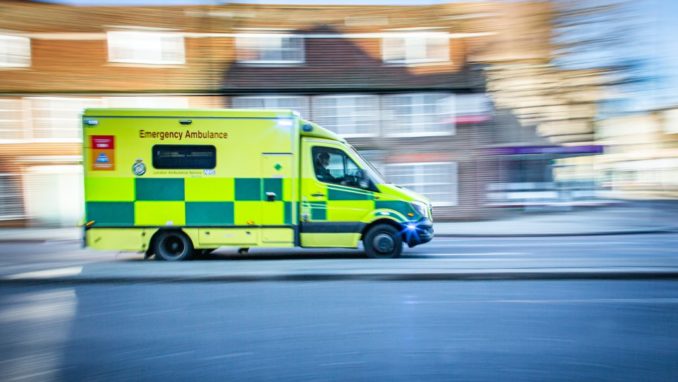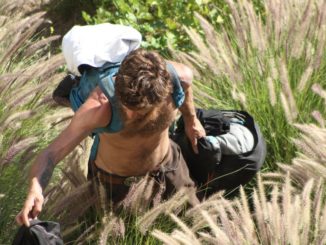
Some seven years ago, after experiencing the dizzying effects of a very low pulse rate, I was given a pacemaker and, as an anti-clotting precaution, a blood-thinning medicine, which I was taking for several years without ill effect – except one: a regular dose of anti-clotting agent does just that. Bleeding, whether caused by a razor-nick, nose bleed or a minor cut, simply carries on bleeding. Mostly, this is not a serious inconvenience because a plaster or cotton wool eventually does the trick. But a couple of months ago, it seems that ulcers I didn’t even know were there – one in the duodenum and one in the upper stomach – bled one night and caused some serious haemorrhaging in the morning.
I’ll spare you the details, but because I lost a lot of blood my wife and daughter called an ambulance which whisked me off to North Middlesex University Hospital, which was nearest. The ambulance drove straight into the Accident & Emergency (A & E) Unit, where the efficiency and quality of care was exemplary.
I was then moved into a ward upstairs and given two blood transfusions to make up for the loss of blood from the earlier haemorrhage, followed by a succession of intravenous inputs of glucose, antibiotics and other unnamed liquids, while also having repeated blood pressure tests.
Intravenous dehydration
I noticed that the instruction board on the wall behind my head declared, in large capital letters, “NIL BY MOUTH”, which explained why, in response to my pleas for something to drink to alleviate my thirst, I was given a small, wet sponge on a stick to suck. I appealed to a passing nurse, who dismissed my request for a drink with “you are being given intravenous fluids to prevent dehydration” and a nod towards the notice behind my head.
My arm was a pin-cushion of intravenous needles connected to bags of assorted liquids hanging from a stalk on wheels, and I soon tired of enquiring what was going on and getting meaningless or contradictory replies. Then I was wheeled into the endoscopy department where a minute camera on a long stalk was fed down my throat. It photographed the two ulcers ostensibly responsible for the bleeding that morning. I was then wheeled back to the ward, admitted as an in-patient, and dosed with Lansoprazole to heal the ulcers. My devoted wife, Anita, who always accompanies me on hospital excursions, went home and brought me some bedclothes and newspapers.
Hospital – all human life is there
There were eight others in the ward, including a troubled youth whose caring father sat at his bedside all day. He soothed the boy, engaging him in quiet conversation most of the day. When his father left he mumbled about being desperate for a cigarette. A nurse told him firmly that smoking is forbidden in the ward, but that there’s a smoking area in another part of the hospital, to which she then directed him. An hour later he was manhandled back into the ward by two powerful handlers who pinned him to the floor, arms behind his back. Once released he said he wished to discharge himself, and stuffed his few things into a rucksack. One of the handlers made a phone call to someone in authority, audible to everyone in the ward. The voice stated that if a patient wishes to discharge himself, he is entitled to do so and should not be obstructed. The heavies let the youth go and we didn’t see him again – but not a word was sent to his poor father.
At 5 pm supper arrived and was eagerly consumed by everyone except Nil-By-Mouth patients – ie me, and I was given a bowl of watery, tasteless gruel for my supper. At 8.30 lights went out and I tried to get some shut-eye. But the incessant electronic bleeping machine just outside the ward kept me awake. It was a two-stage bleep: *** rapidly followed by ** But the triple bleep was pitched a semitone above the double bleep that followed a split-second later, and after listening to this ghastly, maddening electronic noise for hours I must have dropped off.
Juice? I’ll check if it’s on your drug-list
In the morning I made my complaint abundantly clear and was moved to a different ward, also fully occupied. I was intrigued to note that the bed opposite was occupied by a somnolent patient attended on one side by a burly policeman and, on the other, a large muscular policewoman. The police read magazines and conversed quietly while their untroubled prisoner snoozed the day away. By now the nil-by-mouth curse was getting me down and I wondered whether this was their way of getting even with me for having dared to complain. Even my request for a glass of juice was met with “I’ll check if it’s on your drug-list”. An hour later it still had not arrived.
After two days without sustenance, any mental exertion, such as reading, was impossible. The day drifted into evening and, as usual, the supper orderlies noted the nil-by-mouth injunction and the chicken casserole passed me by. The only light not extinguished at “lights-out” was a powerful one right above my bed. I asked a nurse to switch it off, but hours later it was still on. I crept quietly out of bed, found the switch and did it myself. No one noticed.
Real, live chain-gang
Despite the relentless bleeping I managed to fall asleep, comforting myself with the vow that, no matter what, I would not spend another night in this torture-chamber, even if it meant discharging myself and walking home in my underpants. Then I was wrenched awake by the sound of grinding, clanking chains being dragged across the bare floor – I got up on an elbow to discern in the faint light the prisoner from across the aisle shuffling his way towards the loo, his manacled ankles and wrists making enough noise to waken the dead. The policeman waited at the toilet door until the poor wretch arrived there, unlocked his iron wrist-band and let him enter. I was told next day that this apparently harmless chap was actually a violent criminal!
By and large I found that the patient-facing nursing staff are dedicated, disciplined and caring, resigned to face and deal with the trials they face every day. They are aware of the horrendous waste that plagues governmental departments, including the NHS. They know that stuff is purchased but never used, that projects are commenced only to be abandoned, and are as saddened as the rest of us that it has come to this. These upholders of belief in the NHS are as frustrated and appalled by its failings – yet they carry on regardless, day-in and day-out.
Back to our prisoner: after he jangled and clanked his way back to bed, silence reigned, apart from the incessant *** /**bleeping which made sleep impossible, even with an extra pillow over my head. Next morning I went to the desk just outside the ward and informed the presiding matron that the bleeping machine was driving me crazy and begged her to switch it off. She was visibly horrified and informed me that the bleep-emitter on her desk was connected to all the cardiac patients in the ward, and only someone’s cardiac arrest can cause it to stop. “Is that what you want? To allow a heart patient to die so you can get some sleep?” I resisted the temptation to answer “Yes please” and, having learnt in school that this is what’s known as a “rhetorical” question and requires no answer, I applied Falstaff’s aphorism that “discretion is the better part of valour”, and muttered my way back to bed, comforted by the irreversible certainty that this was my last day in this place, no matter what!
Reversing the bleeps
After phoning Anita and asking her to bring me fresh clothes and some grapes to break my fast, I thought more about my exchange with the matron about the bleeping. It struck me that the whole concept was back-to-front: a cardiac arrest should be signalled by a blast of bleeps, not by a cessation of bleeps – the machine should remain silent until someone’s heart stops…….It would be an all-round winner: if more patients got more sleep there would be fewer neurotic, nail-biting, hair-pulling nutcases in our hospitals. Such an innovation may well be technically feasible, but its implementation might require a private firm to be contracted to devise the circuits, integrate them within the hospital’s existing electronic infrastructure, and install the required number of units.
Which got me thinking about wider NHS issues. Several European countries with a comparable level of health spending have better outcomes. Our annual spending on healthcare is £277 billion (equating to £4,000 per person and amounting to 12 per cent of GDP), 83% of which is provided through taxes. In the most successful of these countries there is a greater mix of state and private provision. In some cases private sector disciplines are injected by a vibrant insurance market, which could easily be replicated in the UK, given its position as the world’s largest insurance resource. Or we could simply encourage companies to tender for contracts, to be awarded via a rigorous (and transparent) process, uncorrupted by the favouritism that tainted the Johnson administration’s “personal protective equipment” (PPE) tendering scandal., among others.
This is no place to analyse the many failings of the health service – whether procedural, financial or basic delivery. What we do know is that (i) one government after another has grappled in vain to come anywhere near meeting the service criteria that the community requires, in terms of waiting times for appointments, treatments – or simply an ambulance; (ii) these failings get worse as the funding increases; and (iii) there is an overwhelming case for inviting initiatives from the private sector to tackle the abiding problems that have plagued the health service for so many decades.
Now that it is in the worst crisis in its history it is no answer to pour still more money into this bottomless pit.
© Emile Woolf October 2022 (website)



